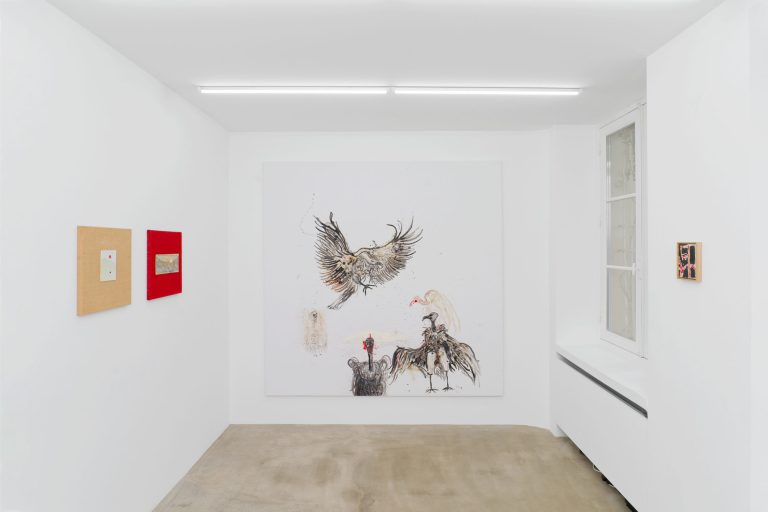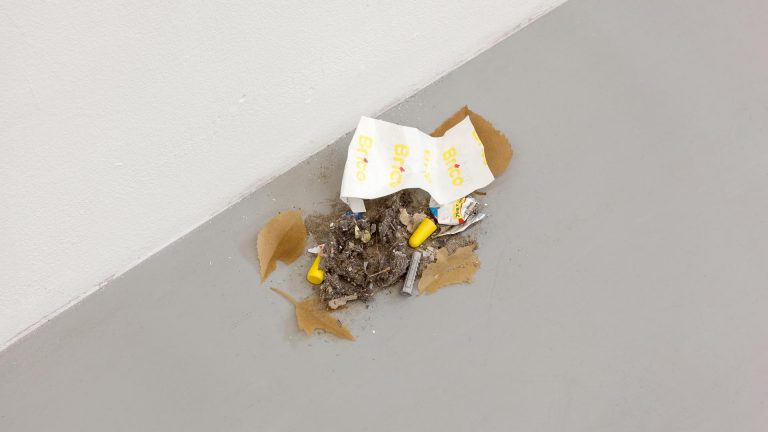Artist: Hana Miletić
Exhibition title: XX
Venue: LambdaLambdaLambda, Prishtina, Kosovo
Date: September 21 – November 13, 2021
Photography: marcelkoehler.com / Courtesy the artist and LambdaLambdaLambda, Prishtina
Hana Miletić’s XX proposes a series of binary inequalities, sharply delineated and forced into simultaneity, through the work’s marshaling of image, raw material, place, and movement. The unequal relationships drawn together here are distinct yet securely bound in plainly presented interrelation. Beyond the ‘socio-economic’ or ‘geopolitical,’ of which they also are, they encompass the bifurcate experience of human passage, aesthetic hierarchy and material value, and manual and artistic labor. In Basel, Switzerland, which maintains its independence from the EU as part of a pursuit of economic dominance underwritten by nationalist sentiment, Miletić photographed minor repairs in public space, perhaps made by Kosovar or other laborers from the former Yugoslavia, a significant migrant labor population in the region. Woven proxies for these repairs are exhibited in Pristina, the capital of Kosovo, a state not only without EU membership but whose very sovereignty remains contested. The converse path also occurs, with textile repairs from the streets of Pristina ushered into the fair in Basel. The steeply disproportionate yet mirrored status of these two sovereigns – outside the EU under starkly uneven terms – provides the foundation for XX’s spate of binaric proportions. For example, in view of this national script, the repairs’ enact the art and craft divide: the handwoven articles teeter between displayed object or unusual household item, delicate relic or graffer tape, and tapestry, farm-house quilt or industrial debris. These separations – between art and craft, low and high material – are situated as maintained by labor hierarchy.
XX doesn’t offer or illustrate something as much as enact a series of displacements, which, in their canceling or ‘X-ing’ out of their referent, assume the binary in question while refuting it. Consider the collection of repairs in Basel. These fragile remains copy scenes from granular life in Pristina, partially displacing Basel as the site of current viewership. Are you in Basel, or are you in Pristina, peering at the fine handiwork used to tape a car window back together? In this sense, Miletić has removed the ground of the exhibition you stand in, and the centrality of Basel to its present viewership. At the same time, Basel is excluded but not disappeared, its structural link to Pristina artificially demoted in the autonomous space of XX, at this fair. This artificial demotion serves to highlight, as a temporary inversion, the reigning dominant relation of Switzerland to Kosovo and other “economies in transition,” or the UN’s term for the rank of the former Yugoslavia in its annual “country classification,” or development status report.[1] It is worth noting that the UN does not use the name Kosovo in its report, despite supposedly recognizing its statehood.
In a very simple sense then, these “exports” from Pristina indicate but refuse the standard capital flow between developed and so-called “transitional” national economies. The repairs, oddly shaped and at first unplaceable, roughly indicate the textile, raw goods like wool, rubber, and metal, and partially constructed commodities that makeup Kosovo’s small export economy. Indeed, Miletić used unprocessed wool from Kosovo for the durable warp threads in these weavings. What they depict – small jobs culled from auto shops, delivery vehicles, and broken shop windows – incorporates the Kosovarian populous that lives and labors in Basel, but by bypassing their direct representation. XX brings this population into the exhibition space by presenting the relation dictating the value of their labor time –Switzerland as a “developed” nation and Kosovo as “transitional” – rather than an image, or even a direct trace, of individuals, everyday life, or craftwork. Further, the work insists on inaugurating a sense of the spatial reality of Pristina through great but withheld minute detail: specific street corners, moments of tape holding glass or cardboard, or wind ballooning a piece of tarp clinging to the side of a building. This device, in lush temporality, makes embodied an otherwise abstracted bond of economic subordination.
XX’s conceptual framework mines the structure of weaving. The Basel and Pristina exhibitions are polar points, integral but opposed, which provide the tense structure for the ‘warp and weft’ constitutive of XX’s overarching meaning. To put this another way, the displacement or exclusion of Switzerland within the Basel exhibition you stand in – overtaken by material and daily rhythm from Pristina – is achieved through employment of this dual structure. Like the warp beneath the weft, Basel isn’t obliterated in the scene of the present exhibition, nor ignored in an attempt to perform the importance of the subordinated state, but excluded while shown in its constitutive interdependence, or as inseparable from its relation to Kosovo. More broadly, XX suggests the impossibility of any “developed” economy without that of the “transitional,” breaking both down to another kind of abstract duality (XX), which is contrasted using material evidence, in faithful copies, of the ordinary sameness – yet striking separation – between the two as physical sites.
What of Basel in Pristina? These repairs are of a different color palate, indexing the individual and perhaps municipal routines that attend the minor constructions: in Pristina blue and gray tape predominates, so much so it seems it may be a requirement. In Basel, a diversity of adhesives (light brown, pink, red) suggest a larger consumer market, and perhaps an individual predilection for petty hole filling, as catalogued in the tiny mends on mailboxes and car bumpers in otherwise good shape. Exhibited in Pristina, the Basel repairs unravel, through multiple woven techniques, the façade of Switzerland’s unabridged national script, fraying, by threads drawn from within the state itself, its claim to absolute and unmediated sovereignty. Whereas in the Basel exhibition, Switzerland was excluded from the frame, in Pristina, in a country vying for trade with and recognition from the EU, the repairs centralize a view of the dominant state which depicts it as, although wealthy, fragmented, even unstable, with regard to any claim of national cohesion. Even beyond a critique of Swiss nationalism, what is shown in Pristina is the intangibility of the designation of “developed.” The weavings speak to an immediate and shared world because the repairs from the two cities are only subtly different; wherein everything ultimately breaks down and must be renewed, and where tape is tape, and thread is thread. Conversely, the change in materials in the textile shown in Pristina – the heavy and small gold weave, like jewelry or currency, and bright pinks and blues – suggest a density and diversity of capital in Basel, casual and indifferent to the conditions anywhere else.
For viewers in Pristina, if we are assuming they are Kosovar which they may not be, it is possible relatives or old neighbors who immigrated to Basel made the repairs copied in textile, which posits another experience of both the geopolitical binary and the individual weavings themselves. To receive Switzerland as always already never itself, as not presently possible in its own narrative – and rather continually dependent on others for its most miniature rehabilitations — is the sight advantage from the “transitional” periphery. From here too, where the main export is labor power, the repairs that return become corporeal: the red and nude colored knit like gauze over flesh, or tiny segments of bright pink intestine roughly wrapped in cotton. The weavings’ handmade-ness – their physicality and organic unevenness – speak to the cost, a ‘pound of flesh,’ of national borders amid global economic competition.
– E. C. Feiss
[1] United Nations, and United Nations Conference on Trade and Development, 2020. World Economic Situation and Prospects (New York, N.Y.: United Nations) 165. https://www.un.org/development/desa/dpad/wp-content/uploads/sites/45/WESP2020_Annex.pdf
Hana Miletić (b.1982, Zagreb, Croatia), lives and works in Brussels and Zagreb. Recent solo exhibitions include Bergen Kunsthall, Bergen (2021); La Loge, Brussels (2021); WIELS, Brussels, Belgium (2018); and participation in the 13th Sharjah Biennial (2017). Group ex-hibitions include 58th October Salon, Belgrade (2021); KAI 10 | Arthena Foundation, Düs-seldorf (2021); 39th EVA International, Ireland Biennial of Contemporary Art; Art Encoun-ters Biennial, Timișoara (forthcoming 2021); Muzeum Sztuki, Łódź; Kunsthalle Wien, Vienna (2020); S.M.A.K., Ghent and TextielMuseum, Tilburg (both 2018-19). Past residencies include: The Cultural Centre of the Josef and Anni Albers Foundation in Senegal (2019), and the Jan van Eyck Academy in Maastricht (2014-2015). In the last few years, Miletić has facilitated collaborative projects at Globe Aroma, Brussels and De Appel, Amsterdam.
Exhibition view, Hana Miletić, XX, LambdaLambdaLambda, Prishtina, 2021
Hana Miletić, Materials, 2021, Hand-woven textile (butter yellow peace silk, lemon yellow flax and white organic raw wool), 2 elements installed appr.: 45 x 45 x 2 cm (17 3/4 x 17 3/4 x 3/4 inches), left element: 24 x 20 x 2 cm (9 1/2 x 7 7/8 x 3/4 inches), right element: 23 x 20 x 2 cm (9 x 7 7/8 x 3/4 inches)
Exhibition view, Hana Miletić, XX, LambdaLambdaLambda, Prishtina, 2021
Exhibition view, Hana Miletić, XX, LambdaLambdaLambda, Prishtina, 2021
Hana Miletić, Materials, 2021, Hand-woven textile (ash grey eucalyptus yarn, bright yellow organic raw wool, butter yellow peace silk, grey peace silk, lemon yellow linen and silk, silver metal yarn, stone grey eucalyptus yarn and yellow recycled rubber), 160 x 270 x 3 cm (63 x 106 1/4 x 1 1/8 inches)
Hana Miletić, Materials, 202, Hand-woven textile (black organic linen, black organic raw wool, brown-grey organic raw wool, burned recycled wood fibre and dark blue organic linen), 68x 67×2,5 cm (26 3/4 x 26 3/8 x 1 inches)
Exhibition view, Hana Miletić, XX, LambdaLambdaLambda, Prishtina, 2021
Exhibition view, Hana Miletić, XX, LambdaLambdaLambda, Prishtina, 2021
Hana Miletić, Materials, 2021, Hand-woven textile (brown-grey organic raw wool, chestnut wool and silk, pale grey silk raphia, silver metal yarn, silver waxed cord and smoke grey silk paper), 23 x 44 x 2 cm (9 x 17 3/8 x 3/4 inches)
Hana Miletić, Materials, 2021, Hand-woven textile (brown-grey organic raw wool, copper knotted metal yarn, gold metal yarn, old gold metal yarn and pale gold recycled polyamide), 18,5 x 11 x 1 cm (7 1/4 x 4 3/8 x 3/8 inches)
Hana Miletić, Materials, 2021, Hand-woven textile (copper knotted metal yarn, brown-grey organic raw wool, grey recycled cotton, old gold metal yarn and silver metal yarn), 32,5 x 20 x 1 cm (12 3/4 x 7 7/8 x 3/8 inches)
Exhibition view, Hana Miletić, XX, LambdaLambdaLambda, Prishtina, 2021
Exhibition view, Hana Miletić, XX, LambdaLambdaLambda, Prishtina, 2021
Exhibition view, Hana Miletić, XX, LambdaLambdaLambda, Prishtina, 2021
Hana Miletić, Materials, 2021, Hand-woven textile (bright yellow organic raw wool, brown-grey organic raw wool, butter yellow peace silk, dark grey silk raphia, lemon yellow linen and silk, pale grey silk raphia, silver metal yarn, stone grey recycled plastic and cotton, vanilla organic silk noil and yellow recycled rubber), 169 x 18 x 1,5 cm (66 1/2 x 7 1/8 x 5/8 inches)
Hana Miletić, Materials, 2021, Hand-woven textile (arctic blue organic linen and silk, beige recycled polyamide, brown-grey organic raw wool, recycled nylon and white organic linen and silk), 12 x 7 x 4 cm (4 3/4 x 2 3/4 x 1 5/8 inches)
Exhibition view, Hana Miletić, XX, LambdaLambdaLambda, Prishtina, 2021
Exhibition view, Hana Miletić, XX, LambdaLambdaLambda, Prishtina, 2021
Hana Miletić, Materials, 2021, Hand-woven textile (brown-grey organic raw wool, fuscia recycled silk, magenta linen and wool, recycled nylon, recycled rubber, rose pink organic raw wool and white organic raw wool), 2 elements installed appr.: 26 x 41 x 2 cm (10 1/4 x 16 1/8 x 3/4 inches), top element: 11 x 23,5 x 2 cm (4 3/8 x 9 1/4 x 3/4 inches), bottom element: 8,5 x 18 x 1,5 cm (3 3/8 x 7 1/8 x 5/8 inches)
Hana Miletić, Materials, 2021, Hand-woven textile (black organic linen, black peace silk, recycled nylon, recycled rubber, red organic raw wool, repurposed plastic, scarlet red mercerised cotton and tart red silk raphia), 60 x 75 x 3 cm (23 5/8 x 29 1/2 x 1 1/8 inches)


























